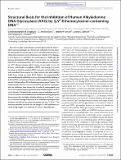| dc.contributor.author | Lingaraju, Gondichatnahalli M. | |
| dc.contributor.author | Davis, Christopher A. | |
| dc.contributor.author | Setser, Jeremy Wayne | |
| dc.contributor.author | Samson, Leona D | |
| dc.contributor.author | Drennan, Catherine L | |
| dc.date.accessioned | 2011-06-30T18:29:55Z | |
| dc.date.available | 2011-06-30T18:29:55Z | |
| dc.date.issued | 2011-04 | |
| dc.date.submitted | 2011-02 | |
| dc.identifier.issn | 0021-9258 | |
| dc.identifier.issn | 1083-351X | |
| dc.identifier.uri | http://hdl.handle.net/1721.1/64727 | |
| dc.description.abstract | Reactive oxygen and nitrogen species, generated by neutrophils and macrophages in chronically inflamed tissues, readily damage DNA, producing a variety of potentially genotoxic etheno base lesions; such inflammation-related DNA damage is now known to contribute to carcinogenesis. Although the human alkyladenine DNA glycosylase (AAG) can specifically bind DNA containing either 1,N6-ethenoadenine (ϵA) lesions or 3,N4-ethenocytosine (ϵC) lesions, it can only excise ϵA lesions. AAG binds very tightly to DNA containing ϵC lesions, forming an abortive protein-DNA complex; such binding not only shields ϵC from repair by other enzymes but also inhibits AAG from acting on other DNA lesions. To understand the structural basis for inhibition, we have characterized the binding of AAG to DNA containing ϵC lesions and have solved a crystal structure of AAG bound to a DNA duplex containing the ϵC lesion. This study provides the first structure of a DNA glycosylase in complex with an inhibitory base lesion that is induced endogenously and that is also induced upon exposure to environmental agents such as vinyl chloride. We identify the primary cause of inhibition as a failure to activate the nucleotide base as an efficient leaving group and demonstrate that the higher binding affinity of AAG for ϵC versus ϵA is achieved through formation of an additional hydrogen bond between Asn-169 in the active site pocket and the O2 of ϵC. This structure provides the basis for the design of AAG inhibitors currently being sought as an adjuvant for cancer chemotherapy. | en_US |
| dc.description.sponsorship | United States. Dept. of Energy (Contract Number DE-AC02-05CH11231) | en_US |
| dc.description.sponsorship | David H. Koch Institute for Integrative Cancer Research at MIT (Graduate Fellowship) | en_US |
| dc.description.sponsorship | Repligen Corporation | en_US |
| dc.description.sponsorship | National Institutes of Health (U.S.) (Grant P30-ES002109) | en_US |
| dc.description.sponsorship | National Institutes of Health (U.S.) (grant GM65337) | en_US |
| dc.description.sponsorship | National Institutes of Health (U.S.) (grant GM65337) | en_US |
| dc.description.sponsorship | National Institutes of Health (U.S.) (Grant CA055042) | en_US |
| dc.description.sponsorship | National Institutes of Health (U.S.) (Grant CA055042) | en_US |
| dc.language.iso | en_US | |
| dc.publisher | American Society for Biochemistry and Molecular Biology, Inc. | en_US |
| dc.relation.isversionof | http://dx.doi.org/10.1074/jbc.M110.192435 | en_US |
| dc.rights | Article is made available in accordance with the publisher's policy and may be subject to US copyright law. Please refer to the publisher's site for terms of use. | en_US |
| dc.source | Prof. Drennan via Erja Kajosalo | en_US |
| dc.title | Structural basis for the inhibition of human alkyladenine DNA by 3,N4-ethenocytosine containing DNA | en_US |
| dc.type | Article | en_US |
| dc.identifier.citation | Lingaraju, Gondichatnahalli M. et al. “Structural Basis for the Inhibition of Human Alkyladenine DNA Glycosylase (AAG) by 3,N4-Ethenocytosine-containing DNA.” Journal of Biological Chemistry 286.15 (2011) : 13205 -13213. © 2011 by American Society for Biochemistry and Molecular Biology. | en_US |
| dc.contributor.department | Massachusetts Institute of Technology. Center for Environmental Health Sciences | en_US |
| dc.contributor.department | Massachusetts Institute of Technology. Department of Biological Engineering | en_US |
| dc.contributor.department | Massachusetts Institute of Technology. Department of Biology | en_US |
| dc.contributor.department | Massachusetts Institute of Technology. Department of Chemistry | en_US |
| dc.contributor.department | Koch Institute for Integrative Cancer Research at MIT | en_US |
| dc.contributor.approver | Drennan, Catherine L. | |
| dc.contributor.mitauthor | Drennan, Catherine L. | |
| dc.contributor.mitauthor | Samson, Leona D. | |
| dc.contributor.mitauthor | Setser, Jeremy Wayne | |
| dc.contributor.mitauthor | Davis, Christopher A. | |
| dc.contributor.mitauthor | Lingaraju, Gondichatnahalli M. | |
| dc.relation.journal | Journal of Biological Chemistry | en_US |
| dc.eprint.version | Final published version | en_US |
| dc.type.uri | http://purl.org/eprint/type/JournalArticle | en_US |
| eprint.status | http://purl.org/eprint/status/PeerReviewed | en_US |
| dspace.orderedauthors | Lingaraju, G. M.; Davis, C. A.; Setser, J. W.; Samson, L. D.; Drennan, C. L. | en |
| dc.identifier.orcid | https://orcid.org/0000-0001-5486-2755 | |
| dc.identifier.orcid | https://orcid.org/0000-0002-7112-1454 | |
| mit.license | PUBLISHER_POLICY | en_US |
| mit.metadata.status | Complete | |
